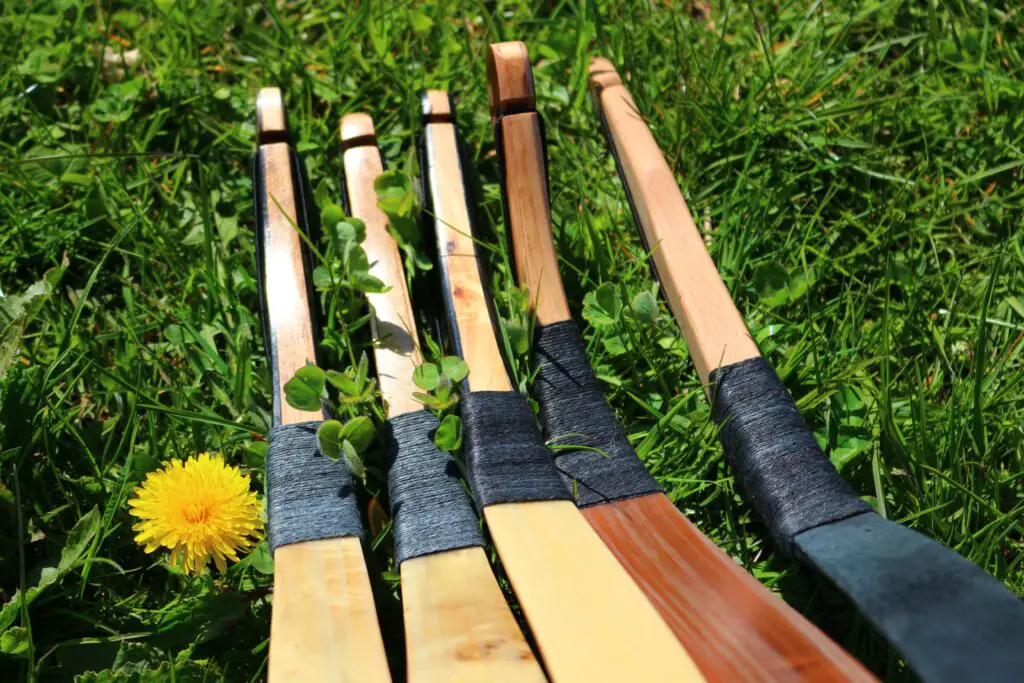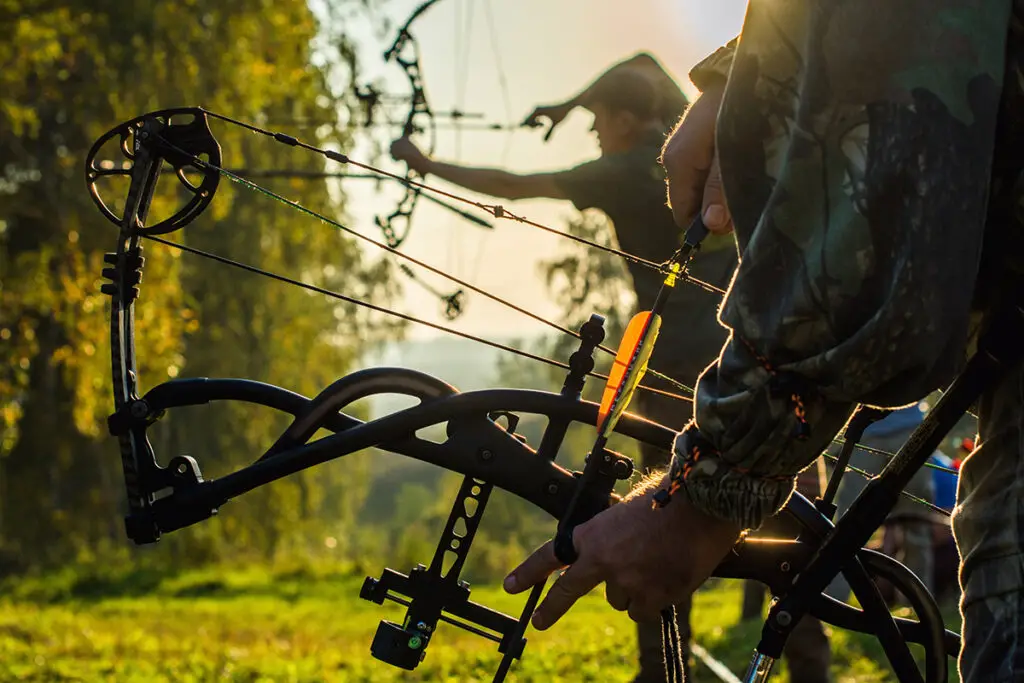If you don’t store your bow in a bag or case, you might wonder whether you can leave a bow strung. Most archers will tell you that you shouldn’t but why? In this article, I will answer that question in more detail. If you are looking for a quick answer, read the bolded paragraph below:
You should not leave a bow strung because it limits its lifespan. This is especially true for wooden bows, but also fiberglass and carbon bows should be kept strung. To increase the lifespan of the bow also make sure to store the bow in a place that is kept at room temperature and is not humid.
Although I believe that you shouldn’t keep a bow strung there is quite some debate around this topic. Therefore, in this article, I want to highlight both sides and discuss in more detail why you shouldn’t leave your bow strung.
How leaving your bow strung limits its lifespan
When you have a bow strung, the bow will be under pre-tension. Depending on the type of bow this should be around 5 LBS. This means that if you leave the bow strung the limbs will always store 5 LBS of energy.
This decreases the lifespan of the bow because the bow slowly loses its flexibility. This happens regardless of whether you have the bow strung or not. But if you have the bow strung this happens much faster.
Think for example of a rubber band. After a while, a rubber band will lose its flexibility. If you store it correctly it will last a lot longer than when it’s stored in less ideal conditions. If you keep the rubber band stretched for a long time it will lose its flexibility much faster.
The same is true for a bow. Keeping the bow under tension will make the bow less flexible. Therefore, the draw weight decreases and the limbs will break faster. Depending on the quality of the bow, it might limit the bow’s lifespan by a few months or a few years.

Why some archers don’t unstring their bow
Still, some archers don’t unstring their bow for two major reasons. Let’s discuss these in more detail.
They don’t think it decreases the life span of a bow
Some archers believe that keeping a bow doesn’t decrease its lifespan. In most cases, they believe this because they have kept their bow strung for years and haven’t experienced any issues. But that is merely anecdotal evidence.
Modern bows are built to be very durable, so a good bow can last a lifetime. In some cases, even if you keep a bow strung it might one or two decades. But still, it would last longer if you would unstring the bow.
Most archers don’t use one bow for such a long time. But the problem is that you don’t know what effect it will have on your bow. Some bows last a long time while others break within a few years.
Unstringing a bow can cause damage to the bow
Although the durability of the bow seems like a compelling reason to unstring the bow. Some archers believe that it’s better to keep the bow strung for this precise reason. This is from the thought that most damage on the bow happens when you string the bow.
That is indeed true. Stringing a bow is relatively simple, but it can go wrong. When this happens, the limbs will vibrate a lot. This is bad for the bow, but it may also cause you to drop it, which can also cause damage to the bow limbs.
Also twisting the bow limb can cause damage to the bow. And this can easily happen if you string a bow without a bow stringer. That’s why I always recommend buying a bow stringer.
If you unstring a bow correctly, it will not cause any damage to the bow. I believe that the harm from keeping a bow strung is worse than the potential risk of unstringing and stringing a bow. So be careful but unstring your bow!
How this differs per type of limb
How much a bow limb suffers from staying strung depends on the build quality and materials of the limbs. Well made limbs should last a long time even when you keep the bow strung. Lesser quality limbs on the other hand can break within a few years even if you follow all guidelines.
There is also a clear difference between the materials used in limbs. Wooden limbs will deteriorate the fastest if the bow is kept strung. Fiberglass is already a lot stronger and carbon limbs will suffer even less.
That doesn’t mean that it’s a good idea to keep a bow with carbon limbs strung. It will suffer less, but it will still deteriorate faster than if you would unstring the bow after use.
Why a compound bow is kept strung
If you are still skeptical, you might wonder whether you don’t have to unstring a compound bow. If it’s bad for the limbs it should also be bad for the limbs of a compound bow right?
Indeed, it would technically be better if we would unstring a compound bow. But doing this is very difficult because we need to use a bow press. If we would use a handheld bow press, like this one that would take at least 15 minutes. And since you also must attach the cables in the right spot, you could easily make a mistake.
Compound limbs also tend to be much stronger than recurve and traditional limbs. At my local archery club, I have seen multiple recurve limbs break while I never saw a compound limb break.
I believe this is the case because compound limbs are made of fiberglass or carbon. They are also thicker than recurve limbs and bend less, due to the working of the cams.

When it’s okay to leave a bow strung
The only good reason I see to keep a bow strung is to put it on display. If you don’t want to shoot the bow but hang it on that wall you probably want to keep the bow strung. A bow looks a bit weird when it’s strung, and it won’t break if you don’t use it.
How to increase the lifespan of your bow
I already drove it home that you can increase the lifespan of your bow, but there is much more you can do. First, make sure to always use a bow stringer. If you don’t have one buy one as soon as possible because you can easily damage the limbs if you string the bow incorrectly.
I recommend a bow stringer that you attach to both limb tips, like this one. These bow stringers spread the force more evenly over the limbs than saddle stringers, which keep the saddle on top of the upper limb.
See the video below for a demonstration of how to use a bow stringer. I use a saddle stringer in the video, but it works very similarly to a stringer you attach to the limb tips.
Also, where you keep the bow influences its lifespan. You want to keep the bow in a room-temperature place that stays dry and doesn’t get humid. Storing your bow in a shed will significantly decrease its lifespan.
Final words
I hope you found this article helpful and that I convinced you to unstring your bow. If you have any questions, comments, or experiences you would like to share, please leave them down below. I would love to hear from you. I will respond to any questions as soon as possible and you will receive an email notification once I have replied.
Tim van Rooijen
For as long as I can remember, I have always been fascinated by archery. First due to its historic significance but later because I like being outdoors. With this blog, I share my knowledge about Archery and how you can improve your shot. More about author…


